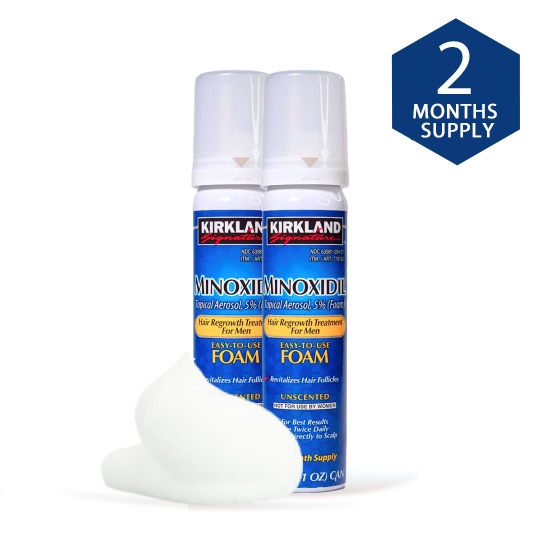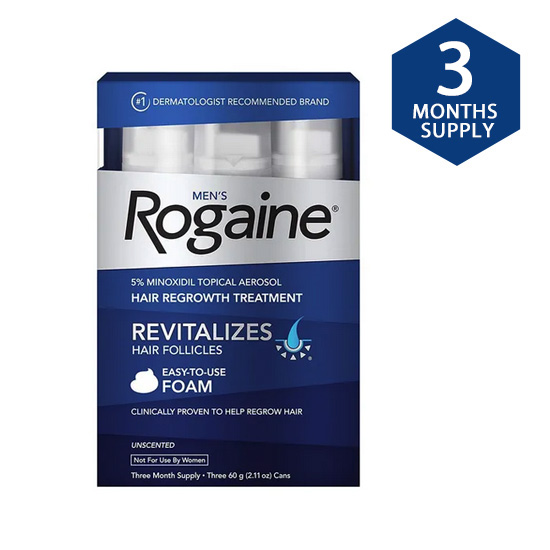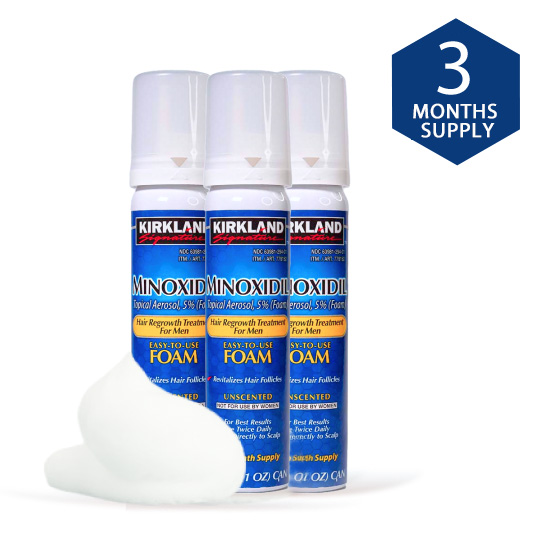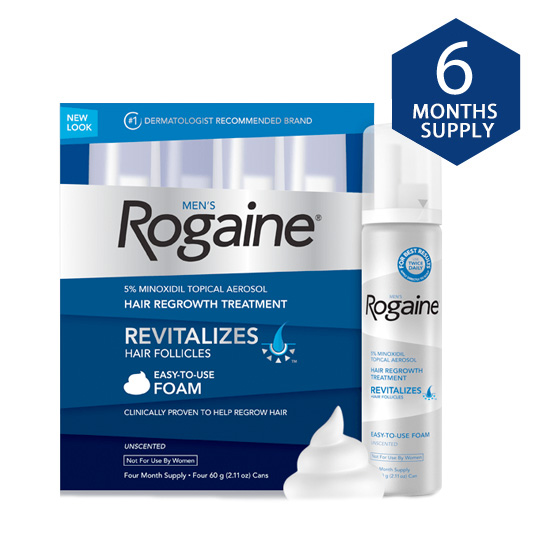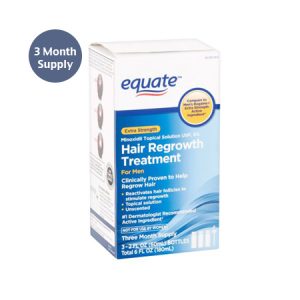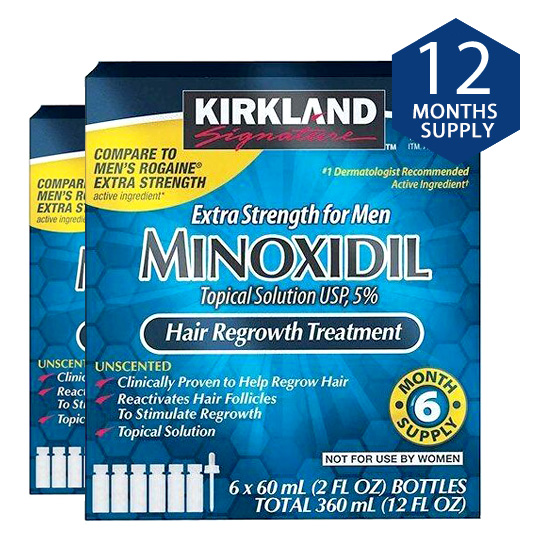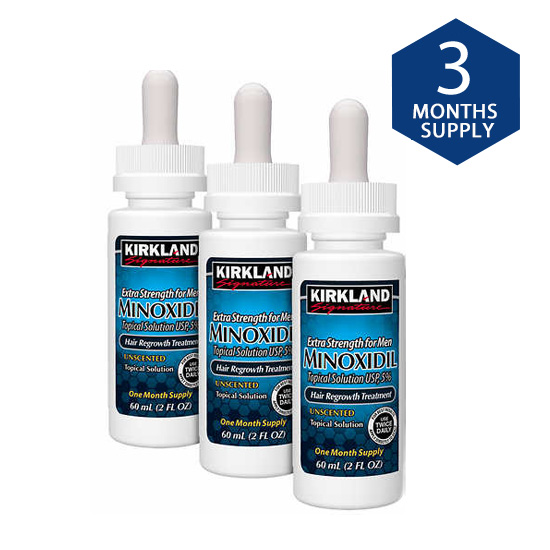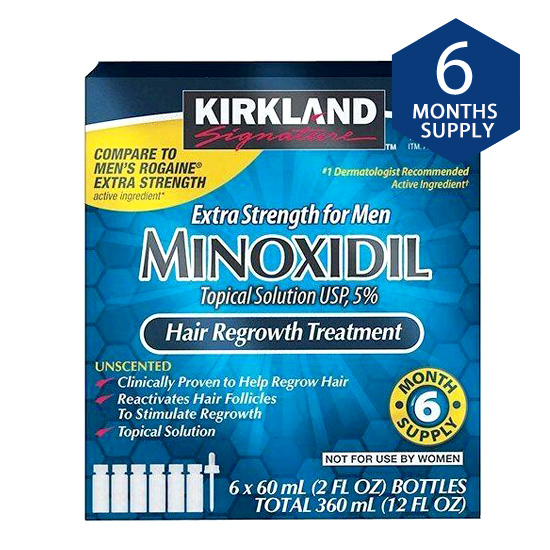Minoxidil For Men

Minoxidil For Men
Please find below our range of Minoxidil for Men. Our range includes Kirkland Minoxidil and Rogaine Minoxidil 5% strength.
-
Premium Derma Roller 540 Titanium .25mm Micro Needles, Includes Storage Case By NexGenSkin
Original price was: $22.99.$16.99Current price is: $16.99. -
Rogaine 5% Foam for Men – 2 Month Supply
Original price was: $79.99.$50.99Current price is: $50.99. -
Kirkland Minoxidil 5% Foam – 1 Month Supply
Original price was: $28.99.$18.99Current price is: $18.99. -
Kirkland Minoxidil 5% Foam – 2 Month Supply
Original price was: $57.98.$33.99Current price is: $33.99. -
Rogaine 5% Foam for Men – 12 Month Supply
Original price was: $319.99.$259.99Current price is: $259.99. -
Kirkland Minoxidil 5% Foam – 12 Month Supply
Original price was: $199.99.$145.99Current price is: $145.99. -
Rogaine 5% Foam for Men – 3 Month Supply
Original price was: $99.99.$79.99Current price is: $79.99. -
Kirkland Minoxidil 5% Foam – 3 Month Supply
Original price was: $69.99.$42.99Current price is: $42.99. -
Rogaine 5% Foam for Men – 6 Month Supply
Original price was: $199.99.$146.99Current price is: $146.99. -
Kirkland Minoxidil 5% Foam – 6 Month Supply
Original price was: $99.99.$74.99Current price is: $74.99. -
Equate Extra Strength Minoxidil Hair Regrowth Treatment for Men (3 Month Supply)
Original price was: $49.99.$39.99Current price is: $39.99. -
Kirkland Minoxidil 5% Liquid – 1 Month Supply
Original price was: $22.99.$12.99Current price is: $12.99. -
Kirkland Minoxidil 5% Liquid – 12 Month Supply
Original price was: $99.99.$59.95Current price is: $59.95. -
Kirkland Minoxidil 5% Liquid – 3 Month Supply
Original price was: $39.99.$19.99Current price is: $19.99. -
Kirkland Minoxidil 5% Liquid – 18 Month Supply
Original price was: $129.99.$85.99Current price is: $85.99. -
Kirkland Minoxidil 5% Liquid – 6 Month Supply
Original price was: $59.99.$30.99Current price is: $30.99. -
Kirkland Minoxidil 5% Liquid – 9 Month Supply
Original price was: $79.99.$44.99Current price is: $44.99. -
Regenepure Precision For Men 5% Minoxidil Spray Hair loss & Regrowth Treatment – 3 Month Supply
Original price was: $129.99.$89.99Current price is: $89.99. -
Regenepure Precision For Men 5% Minoxidil Spray Hair loss & Regrowth Treatment – 1 Month Supply
Original price was: $49.99.$29.99Current price is: $29.99. -
Rogaine Topical 5% Solution for Men, 12 Month Supply (12 60mL Bottles)
Original price was: $319.99.$299.99Current price is: $299.99. -
Rogaine Topical 5% Solution for Men, 3 Month Supply (3 60mL Bottles)
Original price was: $119.99.$84.99Current price is: $84.99. -
Rogaine Topical 5% Solution for Men, 6 Month Supply (6 60mL Bottles)
Original price was: $189.99.$164.99Current price is: $164.99. -
Rogaine Topical 5% Solution for Men, 9 Month Supply (9 60mL Bottles)
Original price was: $299.99.$234.99Current price is: $234.99. -
Basic Care Minoxidil 5% Foam Hair Regrowth Treatment for Men – 1 Month Supply
Original price was: $69.99.$24.99Current price is: $24.99.
Minoxidil for Men: Unlocking the Secret to Fuller Hair
Hair loss is a common concern among men of all ages. It can affect self-esteem, confidence, and overall well-being. Fortunately, advances in medical science have provided effective solutions to combat hair thinning and loss.
One such solution is Minoxidil, a topical treatment that has gained widespread popularity for its ability to promote hair growth and prevent further loss. This article delves into the details of Minoxidil for men, exploring its benefits, usage, and effectiveness.
Understanding Hair Loss in Men
Before diving into the specifics of Minoxidil, it is essential to understand the underlying causes of hair loss in men.
The most common type is androgenetic alopecia, also known as male pattern baldness. This condition is largely genetic and is influenced by the hormone dihydrotestosterone (DHT), which causes hair follicles to shrink and eventually stop producing hair. Other factors contributing to hair loss include stress, poor diet, certain medications, and medical conditions.
What is Minoxidil?
Minoxidil was originally developed as an oral medication to treat high blood pressure. However, during clinical trials, researchers noticed an interesting side effect: increased hair growth.
This discovery led to the development of Minoxidil as a topical treatment for hair loss. Today, it is available over the counter in various strengths, most commonly 2% and 5%, with the latter being more popular among men.
How Does Minoxidil Work?
Minoxidil works by stimulating hair follicles and increasing blood flow to the scalp. Although the exact mechanism is not entirely understood, it is believed to widen the blood vessels, allowing more oxygen, blood, and nutrients to reach the hair follicles.
This increased nourishment revitalizes shrunken hair follicles, extending the growth phase of the hair cycle and promoting thicker, fuller hair.
Benefits of Minoxidil for Men
Proven Effectiveness: Numerous clinical studies have demonstrated the efficacy of Minoxidil in promoting hair growth and reducing hair loss. It has been shown to be particularly effective for men in the early stages of hair thinning.
Non-Prescription Availability: Minoxidil is available over the counter, making it accessible for men seeking a convenient and affordable hair loss treatment without the need for a prescription.
Ease of Use: Minoxidil comes in various forms, including liquid solutions and foam. The application process is straightforward, typically requiring twice-daily use on dry scalp.
Versatile Treatment: Minoxidil can be used in conjunction with other hair loss treatments, such as finasteride (a DHT blocker) or hair transplantation, for enhanced results.
Using Minoxidil: A Step-by-Step Guide
Preparation: Ensure your scalp is clean and dry before applying Minoxidil. It is recommended to wash your hair with a gentle shampoo and towel-dry it.
Application: For liquid solutions, use the provided dropper to apply 1 milliliter of Minoxidil directly to the areas experiencing hair thinning. Gently massage it into the scalp with your fingertips. If using foam, dispense about half a capful and apply it in the same manner.
Frequency: Apply Minoxidil twice daily, ideally in the morning and evening. Consistency is key to achieving optimal results.
Patience and Persistence: Hair growth is a gradual process. Initial results may be visible after 3-4 months of consistent use, with more significant improvements occurring after 6-12 months. It is crucial to continue using Minoxidil to maintain the results, as discontinuation can lead to hair loss resuming.
Potential Side Effects
While Minoxidil is generally safe for most men, some users may experience mild side effects, including:
Scalp Irritation: Itching, redness, or dryness of the scalp can occur. Using a moisturizer or switching to the foam formulation may alleviate these symptoms.
Unwanted Facial Hair Growth: Minoxidil can sometimes cause hair growth in areas where it comes into contact with the skin, such as the forehead or face. Careful application can minimize this risk.
Initial Shedding: Some users may experience increased hair shedding during the first few weeks of use. This is a temporary phase and indicates that Minoxidil is working to promote new hair growth.
Maximizing the Effectiveness of Minoxidil
To get the most out of Minoxidil, consider the following tips:
Consistency: Adhering to a regular application schedule is crucial for seeing results. Skipping doses can hinder progress.
Healthy Lifestyle: Maintaining a balanced diet, managing stress, and avoiding smoking and excessive alcohol consumption can support overall hair health.
Scalp Care: Keeping the scalp clean and free from excess oil and debris can enhance the absorption of Minoxidil. Regular exfoliation can also help.
Combining Treatments: Using Minoxidil alongside other hair loss treatments, such as DHT blockers or hair growth supplements, can provide a synergistic effect.
Hair loss can be a distressing experience, but Minoxidil offers a proven and accessible solution for men seeking to combat thinning hair. With its ability to stimulate hair follicles and promote new growth, Minoxidil has become a cornerstone in the fight against male pattern baldness.
By following a consistent application routine and maintaining a healthy lifestyle, men can achieve noticeable improvements in hair density and confidence.
If you’re struggling with hair loss, Minoxidil may be the key to unlocking a fuller, healthier head of hair. Consult with a healthcare professional to determine the best treatment plan for your specific needs, and take the first step towards reclaiming your hair and your confidence.




